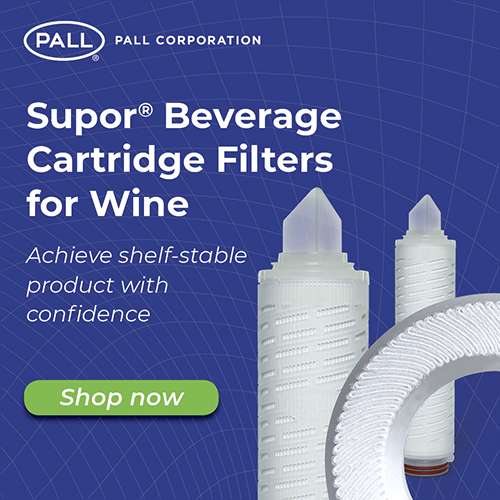Removal of spoilage organisms for a clear and bright wine
Final Filtration Prior to Wine Bottling
The objective of final filtration is to ensure the removal of wine spoilage organisms that can cause re-fermentation, off flavors or turbidity post bottling. The typical wine spoilage organisms include the bacteria Oenococcus oeni and Acetobacter as well as some yeast including Zygosaccharomyces and Dekkera (formerly called Brettanomyces). As the final filter is the last filtration step prior to bottling it is the most critical filtration step in the process ultimately ensuring brand protection.
Filtration is a key unit operation in wine-making to ensure clear, bright and stable wine. While clarification, stabilization and pre-filtration stages remove particles and haze and reduce yeast and bacteria, final membrane filtration is critical to remove wine spoilage organisms that can result in off flavors or ref-fermentation after bottling.
Pall’s recommended membrane filters are laboratory challenge tested to qualify or determine typical retention to wine specific microorganisms like Oenococcus oeni and Dekkera bruxellensis. Furthermore, these final filters are fully integrity testable in situ, providing assurance of product performance.
In addition, Pall’s Supor® beverage filter offers wineries a standard configuration cartridge filter options for final filtration.
Reducing Wine Final Filtration Cost and maintaining Flavor
Supor® Beverage Filter
Supor Beverage filter cartridges are hydrophilic membrane filters designed for reliable retention of spoilage microorganisms in the final filtration wine. The product family comes in two grades 0.45 micron and 0.65 micron.
The cartridge is constructed from one layer of polyethersulfone (PES) membrane in a laid-over pleat configuration. The single open ended (SOE) configuration is designed to fit into sanitary housings to ensure effective microbial reduction and assembly integrity.
Supor Beverage filter cartridges are suitable for exposure to repeated hot water sanitization and in situ steam sterilization cycles for longer service life. The laid-over pleat configuration combined with optimized support and drainage materials, provide increased mechanical strength during operation, repeated hot water, chemical and steam sanitization and thus, high throughput.
For mid and large wine producers and bottlers, Pall offers the Oenofil system. This system utilizes Pall’s extensive experience in cartridge filtration to automate filtration and optimize cartridge filter life.
The Oenofil System
Controlling the filtration process is a key element in achieving quality wines. The Pall Oenofil cold microbiological stabilization system is an automated filtration system designed specifically for wine pre and final filtration prior to bottling. The Oenofil system combines years of process filtration experience, advanced automation and superior cartridge technology to provide cold microbiological stabilization of wine with the highest level of process control, security and brand protection.
Optimal filtration flow rate, selection of cost saving pre-filtration and installation of membrane filters validated for removal of wine specific organisms are all critical factors for successful wine microfiltration. However, proper rinsing, cleaning and sanitization to ensure complete system hygiene are just as critical. The Oenofil automated cartridge filtration system design incorporates these principles.
With Pall’s experience in filtration and understanding of how each stage is interrelated, our Oenofil system enables wineries to reduce filtration costs without sacrificing quality. Streamlining filtration, rinsing and sanitization with optimized protocols can provide up to 30% increased filter service life. Additionally, the flexible working sequences can be combined for cycle programming allowing unattended system operation for reduced labor and downtime.
Depending on the individual customer circumstances, the Oenofil system can be equipped with a Clean in Place (CIP) system to provide proper cleaning, sanitization and storage at the recommended flow rates, chemical concentrations and temperatures. This system, if required, can also control downstream washing and sanitization of the filler and auxiliary equipment, like the bottle washer, for complete process control via a single interface and operation independent of the winery conditions.
